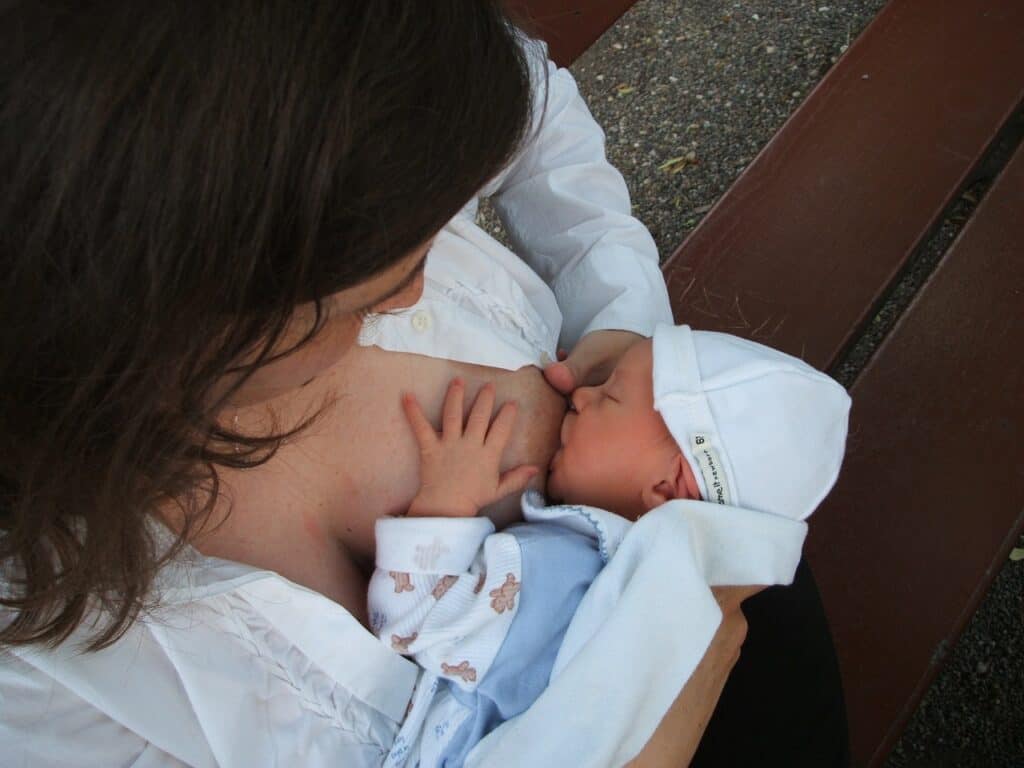Nipple shields are a useful tool for breastfeeding mothers who are experiencing difficulties with latching or nipple pain. However, getting the nipple shield to stay on can be a challenge for many mothers. Without proper application, the nipple shield can easily slip off or cause discomfort for both the mother and baby.
To ensure that the nipple shield stays in place during breastfeeding, it is important to choose the correct size and shape for your nipple. Additionally, proper application and positioning of the nipple shield can make all the difference in ensuring a successful breastfeeding session.
In this article, we will explore how to get nipple shield to stay on and the various factors that contribute to a successful nipple shield experience, including choosing the correct nipple shield, applying it properly, and ensuring a proper latch. We will also address common challenges that mothers may encounter when using a nipple shield and provide tips and advice for transitioning off the shield when the time comes.
Key Takeaways
- Choosing the correct size and shape of nipple shield is crucial for ensuring it stays in place during breastfeeding.
- Proper application and positioning of the nipple shield can help prevent discomfort and ensure a successful breastfeeding session.
- Addressing common challenges and seeking guidance from a lactation consultant can help mothers transition off the nipple shield when the time is right.
Understanding Nipple Shields
Nipple shields are a silicone device that can be used to help with breastfeeding. They are often recommended by lactation consultants and healthcare providers for mothers who are experiencing difficulties with breastfeeding. One of the most popular brands is the Medela Contact Nipple Shield.

Nipple shields are designed to mimic the shape of a mother’s nipple and areola. They are placed over the nipple and areola during breastfeeding to help the baby latch on properly. Nipple shields can be helpful for babies who have difficulty latching on due to a variety of reasons, such as a tongue tie or a cleft palate.
It is important to note that nipple shields should only be used under the guidance of a healthcare provider or lactation consultant. Improper use of nipple shields can lead to further breastfeeding difficulties, such as decreased milk supply or nipple damage.
When using a nipple shield, it is important to ensure that it is properly positioned on the breast. The shield should cover the entire areola and the baby’s mouth should be positioned over the shield. It may take some practice to get the positioning right, but with time and patience, most mothers are able to successfully use a nipple shield.
In conclusion, nipple shields can be a helpful tool for mothers who are experiencing difficulties with breastfeeding. However, it is important to use them under the guidance of a healthcare provider or lactation consultant and to ensure proper positioning during use.
When to Use a Nipple Shield
A nipple shield is a breastfeeding aid that can help mothers who are experiencing difficulties with breastfeeding. It is a thin, silicone cover that is placed over the nipple and areola during breastfeeding. Here are some situations when a nipple shield may be helpful:
Flat or Inverted Nipples
Mothers with flat or inverted nipples may find it difficult for their baby to latch on and breastfeed. A nipple shield can help by providing a larger surface area for the baby to latch onto, making it easier for them to breastfeed.
Sore Nipples
Mothers who are experiencing sore nipples may find relief with a nipple shield. The shield can protect the nipple from further irritation, allowing it to heal.
Tongue Tie
Tongue tie is a condition where the baby’s tongue is attached to the floor of their mouth, making it difficult for them to breastfeed. A nipple shield can help by providing a larger surface area for the baby to latch onto, making it easier for them to breastfeed.
Premature Babies
Premature babies may have difficulty breastfeeding due to their underdeveloped sucking reflex. A nipple shield can help by providing a larger surface area for the baby to latch onto, making it easier for them to breastfeed.
Newborns
Newborns may have difficulty breastfeeding due to their small size and lack of experience. A nipple shield can help by providing a larger surface area for the baby to latch onto, making it easier for them to breastfeed.
It is important to note that a nipple shield should only be used under the guidance of a lactation consultant or healthcare provider. Using a nipple shield incorrectly can lead to further breastfeeding difficulties.
Choosing the Correct Nipple Shield
When it comes to choosing the correct nipple shield, there are a few things to keep in mind to ensure it stays on properly. It is important to note that nipple shields should only be used under the guidance of a lactation consultant or board-certified lactation consultant.

One of the most important factors to consider is the correct size of the nipple shield. A nipple shield that is too small may not stay on properly, while one that is too large may not provide adequate suction. It is recommended to measure the diameter of the nipple and choose a shield that is slightly larger than the measurement.
Another consideration is the material of the nipple shield. Silicone shields are a popular choice as they are durable and easy to clean. They also tend to stay on better than other materials. However, some babies may have a sensitivity to silicone, so it is important to monitor for any signs of irritation.
It is also important to ensure that the nipple shield is positioned correctly on the breast. The shield should be centered over the nipple and the edges should be flush against the breast. This can help prevent the shield from shifting or falling off during feeding.
Overall, choosing the correct nipple shield is crucial for ensuring it stays on properly during breastfeeding. By working with a lactation consultant or board-certified lactation consultant and considering factors such as size and material, parents can find the right nipple shield for their needs.
How to Apply the Nipple Shield
Applying a nipple shield can be tricky, but with the right technique, it can be a game-changer for breastfeeding moms. Here are some steps to follow to help ensure a successful application.
- Cleanse the Nipple and Shield: Before applying the nipple shield, it is important to clean both the nipple and shield thoroughly. Warm water and mild soap can be used to clean the nipple, while the shield can be boiled or soaked in warm water.
- Warm Up the Shield: To help the nipple shield stick, it can be warmed up before application. This can be done by running it under warm water or holding it in the palm of the hand for a few minutes.
- Position the Shield: Once the shield is warmed up, position it over the nipple. The shield should be centered over the nipple, with the tip pointing upwards.
- Create Suction: To create suction, gently press the shield onto the breast and hold it in place for a few seconds. This will help the shield adhere to the breast and stay in place during breastfeeding.
- Skin-to-Skin Contact: Skin-to-skin contact can also help the nipple shield stay in place. Holding the baby close to the breast and allowing them to root around for the nipple can help create a good seal between the shield and breast.
By following these steps, moms can successfully apply a nipple shield and make breastfeeding a more comfortable and enjoyable experience for both mom and baby.
Ensuring Proper Latch with a Nipple Shield
Using a nipple shield can help new mothers with breastfeeding. However, it can be challenging to get the shield to stay on during the feeding process.

A proper latch is essential to ensure that the baby gets enough milk and to prevent discomfort for the mother. Here are some tips to ensure a proper latch with a nipple shield:
- Positioning is key: Ensure that the baby is positioned correctly before attempting to latch on. The baby should be facing the mother, and the nipple shield should be centered over the nipple. The baby’s mouth should be open wide enough to take in the entire nipple and part of the areola.
- Check for a shallow latch: A shallow latch can cause discomfort for the mother and prevent the baby from getting enough milk. Ensure that the baby’s mouth is open wide enough and that the nipple shield is positioned correctly. If the baby is only latching onto the nipple and not the areola, it may be a sign of a shallow latch.
- Encourage a deep latch: A deep latch is essential for the baby to get enough milk and for the mother to be comfortable. Encourage the baby to open their mouth wide and take in as much of the nipple and areola as possible. Gently support the baby’s head and guide them to the breast.
- Make sure the nipple shield is the right size: A nipple shield that is too small or too big can cause discomfort for the mother and prevent the baby from latching on properly. Ensure that the shield fits properly over the nipple and that the baby can latch on comfortably.
By following these tips, new mothers can ensure a proper latch with a nipple shield and make breastfeeding a more comfortable and enjoyable experience for both the mother and baby.
Maintaining Milk Supply
Maintaining milk supply is crucial for breastfeeding mothers who are using nipple shields. Nipple shields can sometimes cause a decrease in milk supply, which can lead to other complications. Here are some tips to help maintain milk supply:

Proper Latching
Proper latching is essential for maintaining milk supply. A good latch ensures that the baby is effectively stimulating the milk ducts, which helps to increase milk production. Mothers can use nipple shields to help with latching, but it is important to ensure that the baby is still latching correctly.
Regular Pumping
Regular pumping is necessary for maintaining milk supply, especially when using nipple shields. Pumping helps to stimulate milk production and ensures that the milk ducts are emptied regularly. Mothers should aim to pump at least 8-10 times a day, especially during the first few weeks after birth.
Breast Massage
Breast massage can help to increase milk production and maintain milk supply. Massaging the breasts before and during breastfeeding or pumping can help to stimulate the milk ducts and improve milk flow.
Proper Nutrition
Proper nutrition is crucial for maintaining milk supply. Mothers should consume a healthy, balanced diet and drink plenty of fluids to ensure adequate milk production.
By following these tips, breastfeeding mothers can maintain their milk supply while using nipple shields. It is important to consult with a lactation consultant or healthcare provider if there are any concerns about milk supply or breastfeeding.
Monitoring Baby’s Weight Gain
Monitoring a baby’s weight gain is important to ensure that they are getting enough milk and growing properly. A pediatrician should be consulted for guidance on the appropriate weight gain for the baby’s age and size.
One of the ways to monitor a baby’s weight gain is to weigh them regularly, such as at every doctor’s appointment. The pediatrician may also recommend weighing the baby at home using a baby scale.
It is important to keep track of the baby’s weight gain over time and to look for any patterns or changes. A sudden drop in weight or lack of weight gain may indicate a problem with breastfeeding or other health issues.
In addition to monitoring weight gain, it is important to pay attention to the baby’s overall health and well-being. Signs that the baby is not getting enough milk or is not growing properly may include:
- Lack of energy or lethargy
- Fewer wet or dirty diapers
- Difficulty latching or sucking
- Fussiness or crying after feedings
- Poor weight gain or weight loss
If any of these signs are present, it is important to consult with a pediatrician to determine the best course of action. With proper monitoring and care, most babies can successfully breastfeed and grow properly.
Addressing Common Challenges
Using a nipple shield can be a helpful solution for mothers who are experiencing breastfeeding difficulties. However, there are some common challenges that mothers may face when trying to get the nipple shield to stay on properly.
One of the most common challenges is soreness. If the nipple shield is not properly positioned, it can cause soreness and discomfort for the mother. To address this challenge, it is important to ensure that the nipple shield is properly centered over the nipple and that there is a good seal between the shield and the breast.
Another challenge that mothers may face is engorgement. When the breast is engorged, it can be difficult to get the nipple shield to stay on properly. To address this challenge, mothers may find it helpful to express some milk before applying the nipple shield. This can help to soften the breast tissue and make it easier to get the shield to stay on.
Mastitis is another challenge that some mothers may face. Mastitis is an infection of the breast tissue that can cause pain, swelling, and redness. If a mother has mastitis, it is important to seek medical treatment. In some cases, using a nipple shield can help to alleviate some of the discomfort associated with mastitis.
Finally, some mothers may simply find it difficult to get the nipple shield to stay on properly. To address this challenge, it may be helpful to try different sizes of nipple shields to find one that fits properly. Mothers may also find it helpful to use a little bit of nipple cream or lanolin to help the shield adhere to the breast.
Overall, while there may be some challenges associated with using a nipple shield, there are also many benefits. By addressing common challenges and finding solutions that work for them, mothers can successfully use a nipple shield to help them breastfeed their babies.
Also, read: Medela vs Spectra S2: Which Breast Pump is Right for You?
Transitioning Off the Nipple Shield

Transitioning off the nipple shield can be a gradual process, and it is important to be patient and persistent. Here are some tips to help make the transition smoother:
- Start by using the nipple shield for the first half of the feeding and then removing it for the second half. This will help the baby get used to feeding without the shield.
- Offer the breast without the shield during times when the baby is calm and relaxed, such as during a nap or after a bath. This can help the baby associate the breast with a positive experience.
- Try different breastfeeding positions, as some positions may be more comfortable for the baby without the shield.
- If the baby is struggling to latch without the shield, try expressing a small amount of milk onto the nipple to encourage the baby to latch.
- It may be helpful to offer a bottle of expressed milk or formula after breastfeeding to ensure the baby is getting enough to eat during the transition period.
Remember, every baby is different and may take longer to transition off the nipple shield. It is important to stay patient and consistent in the process. If you are having difficulty, consider reaching out to a lactation consultant for additional support.
Additional Tips and Advice
When using a nipple shield, it is important to ensure that it stays in place to prevent any discomfort or pain for both the mother and baby. Here are some additional tips and advice to help keep the nipple shield in place:
- Comfort is key: Make sure the nipple shield is comfortable for the mother and baby. If it is causing any discomfort, try adjusting the position or trying a different size.
- Seek breastfeeding support: Joining a breastfeeding support group or seeking advice from a lactation consultant can be helpful in ensuring proper use of the nipple shield and addressing any concerns or issues.
- Use a storage case: When not in use, store the nipple shield in a clean and dry storage case to prevent any contamination or damage.
- Consider medical tape: If the nipple shield is not staying in place, medical tape can be used to secure it. Make sure to use a pliable tape that will not cause any discomfort or irritation.
- Address nipple pain: If the nipple shield is causing any pain or discomfort, consider using lanolin or nipple cream to soothe the area.
- Address gas: If the baby is experiencing gas, try different breastfeeding positions or burping techniques to help alleviate any discomfort.
- Monitor suckling: Make sure the baby is properly latching onto the nipple shield and suckling effectively to ensure proper milk transfer.
- Consult a doctor: If the nipple shield is not staying in place or causing any pain or discomfort, consult a doctor for further advice and guidance.
Related post: Saggy Breasts After Breastfeeding Solutions
Frequently Asked Questions
How do I prevent my nipple shield from falling off during breastfeeding?
To prevent the nipple shield from falling off during breastfeeding, make sure to choose the right size of the shield that fits snugly over your nipple. Also, ensure that the shield is positioned properly on your breast and that your baby is latching onto the shield correctly. You can also try using a nipple cream to help the shield stick to your skin.
What are some tips for using a nipple shield?
Some tips for using a nipple shield include making sure the shield is clean and sterilized before each use, choosing the right size of the shield, and positioning the shield properly on your breast. It is also important to make sure your baby is latching onto the shield correctly and to monitor your baby’s feeding patterns to ensure they are getting enough milk.
What are the different sizes of nipple shields?
Nipple shields come in various sizes, ranging from small to large. The size of the shield you need will depend on the size of your nipple. It is important to choose the right size to ensure a proper fit and prevent discomfort or nipple damage.
Is it safe to always use a nipple shield while breastfeeding?
While nipple shields can be helpful in certain situations, such as when a mother has flat or inverted nipples, it is not recommended to always use a nipple shield while breastfeeding. Overuse of a nipple shield can lead to decreased milk supply and nipple damage.
What are the pros and cons of using a nipple shield?
The pros of using a nipple shield include helping with latch issues, protecting sore or cracked nipples, and allowing mothers with flat or inverted nipples to breastfeed. The cons include decreased milk supply, reliance on the shield, and potential nipple damage if not used properly.
How do I wean my baby off of using a nipple shield?
To wean your baby off of using a nipple shield, gradually reduce the use of the shield during feedings. Start by using the shield for only part of the feeding, and then gradually decrease the amount of time the shield is used until your baby is able to breastfeed without it. It may also be helpful to work with a lactation consultant for guidance and support.

Iesha is a loving mother of 2 beautiful children. She’s an active parent who enjoys indoor and outdoor adventures with her family. Her mission is to share practical and realistic parenting advice to help the parenting community becoming stronger.
